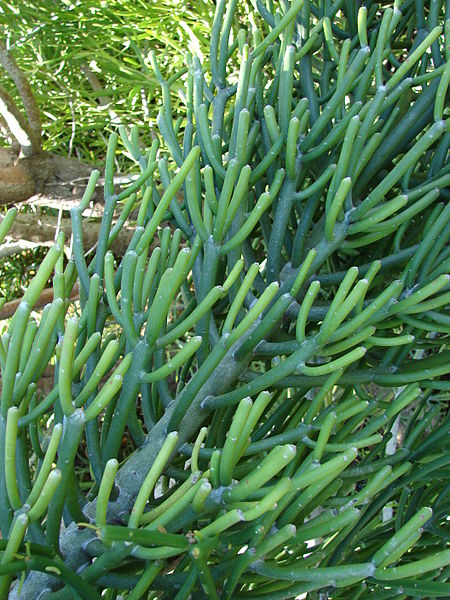
Grow Unusual and Exotic Succulent Plants from Seeds
This sedum stonecrop grows 4-6 inches high. The leaves tint red in the fall and the blooms are dark pink star-like blossoms that will grow from early July to September.
A low growing succulent plant that thrives in well-drained soil but will grow in most soil types. It’s perfect to grow in trouble areas. Deer resistant.
For zones 5-10.
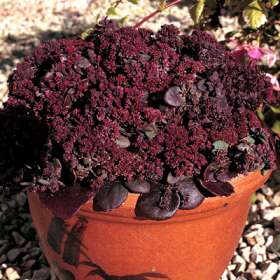
TCB048 Turkish Delight Multi-seed Pellets ( Sedum ussueiense )
Smashing deep burgundy foliage, carmine red flower umbels, for container, border, or rockery. Excellent pot plant. Grows about 6″ tall, hardy to zone 3 outside.
Each multi-seed pellet contains several seeds.
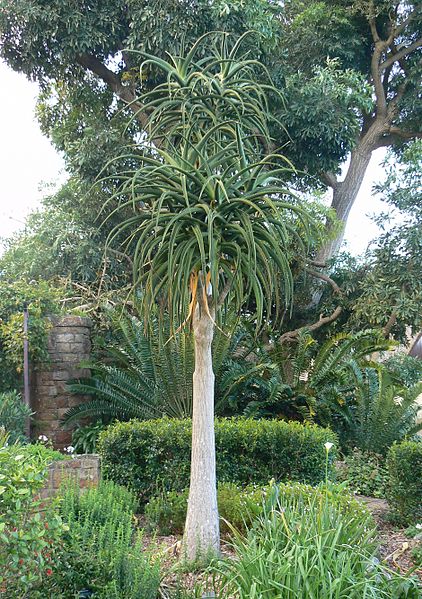
IP316 Tree Aloe ( Aloe barberae )
The largest of all Aloe can grow into a veritable tree but can also be grown in containers for many years. This large succulent grows into a tree 30 feet tall or more with upright-growing thick mottled gray stems. The terminal branches hold rosettes of recurved, dark green leaves. In late winter, the rose-pink flowers in a tight inflorescence rise above the foliage. Plant in full sun or light shade in a fairly well drained soil and irrigate only occasionally to infrequently.
It is moderately drought tolerant and you should be careful not to overwater or plant in an area that has standing water.
Hardy to about 25 degrees F and reportedly survives short durations down to 22 degrees F. It is a great tree for the succulent garden and is fairly clean so good near a pool and can be kept many years in a large container. It does get a thick buttressed base with age so make sure to given it enough space to grow.
This large tree aloe grows naturally in the eastern part of southern Africa in Eastern Cape, KwaZulu-Natal, eastern Swaziland, Mpumalanga (Barberton District) and southern Mozambique where it is found in evergreen and margins of dry deciduous forests.
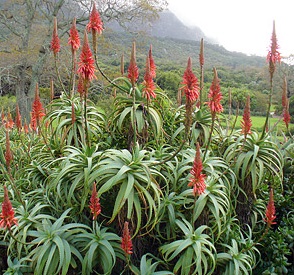
W157 Torch Aloe ( Aloe arborescens )
Aloe arborescens, commonly known as the Krantz Aloe, belongs to the Aloe genus, which it shares with the well known and studied Aloe vera plant. This species is also relatively popular among gardeners and has recently been studied for possible medical uses. It is the only other member of the Aloe family that is claimed to be as effective as Aloe Vera for medical uses.
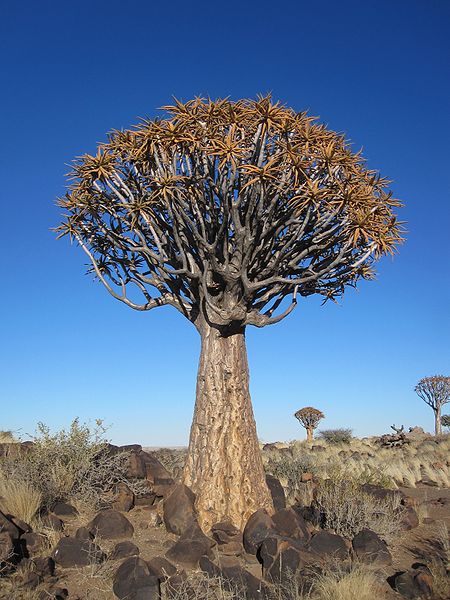
SF311 Quiver Tree ( Aloe dichotoma )
Perhaps the most amazing of the Aloe, this species from desert areas in western central and southern Namibia and the northern Cape Province in South Africa forms a large, smooth, succulent trunk to about 6 m tall which holds a big, rounded crown of small rosettes of bluish green leaves. Perfect for the dry tropical or warm temperate garden in USDA Zones 9 and above.
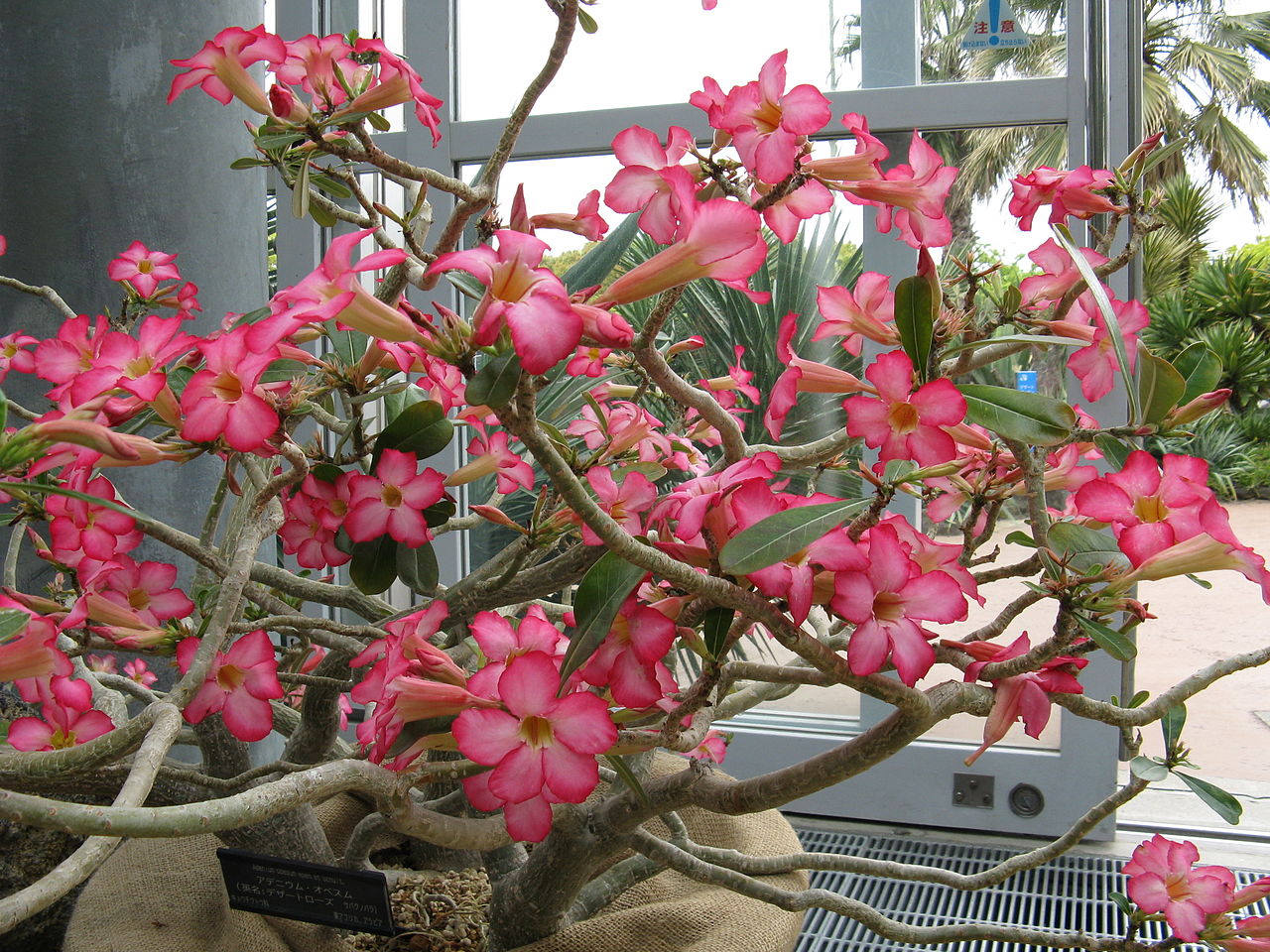
3557 Desert Rose ( Adenium obesum )
If you would like to grow a gorgeous houseplant requiring very little care, you cannot go wrong with the common Desert Rose plant.
This carefree succulent boasts an unusual trunk (caudex) shape coupled with bunches of beautiful, colorful, trumpet-shaped flowers in an abundance of carmine-rose colors.
The plant makes an excellent warm-weather addition to your patio, deck or landscape, and it also does very well as a bonsai or houseplant.
Winter hardy to Zone 11. In colder zones, plants should be grown in containers and overwintered indoors. In containers, desert rose is best grown in a loose, sandy or gravelly, well-drained soil mix in full sun. Plants have excellent heat tolerance. Apply regular moisture during periods of growth, but allow soils to dry between waterings. Regular applications of fertilizer in spring will help promote flowering. Plants can be left outdoors in sunny locations during the summer. As soon as temperatures begin to dip below 55 degrees F. in autumn, bring containers indoors to sunny but cool locations with reduced watering. Plants usually lose their leaves in winter and go into a dormancy-like period. For container plants, the best caudex usually develops from seed-grown plants.
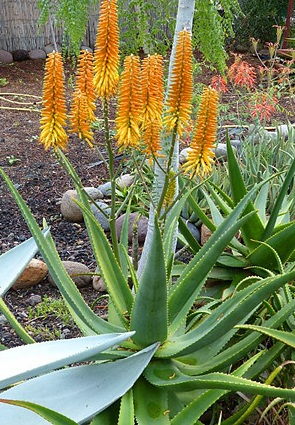
D9910 Aloe Kaokoensis
A wonderful, moderately large Aloe with pale bluish, leaves in a spreading crown, a short, usually decumbent stem and large, branched inflorescences with reddish flowers fading to yellowish when opening. Aloe kaokoensis is native to the Otjihipa Mountains in northern Namibia. In cultivation it is best suited to dry, warm temperate and some tropical climates in USDA Zones 9 and above, but is also easily grown in containers in cooler climates.
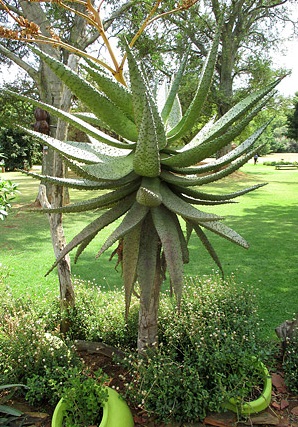
IP319 Mountain Aloe ( Aloe marlothii )
A stunning, large Aloe widely distributed in so-called bushveld vegetation South Africa, Botswana, Swaziland, Zimbabwe and Mozambique to 6000 feet.
It grows a robust, solitary trunk that can reach an amazing 18 feet. The large, succulent, grayish to bluish green leaves can reach 4-5 feet long and are studded with short spines above and below. The old leaves form a dense skirt around the trunk below the crown. The large inflorescence holds a large number of flowers that can vary from yellow to orange to red.
In cultivation it is an easy to grow species for the dryish, warm temperate to tropical garden that can take drought and some cold with light freezes.
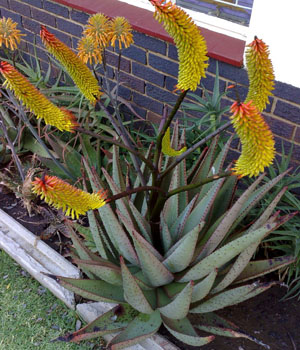
IP305 Aloe Spectabilis
This attractive aloe makes a good houseplant. It is not hardy ( zone 9 outside ), but is easily grown indoors year round. The leaves can grow a few feet in lenght outdoors but are smaller when grown inside, and are light grey to blue green in color. The edges are serrated with chesnut coloured teeth. The attractive flowers appear in the winter or spring.
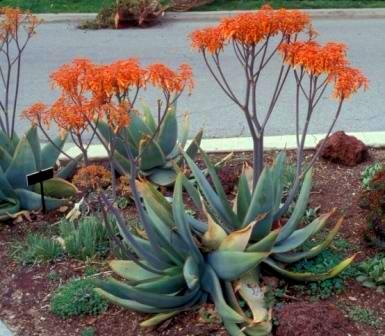
FB143 Coral Aloe ( Aloe Striata )
A solitary succulent to about 18 inches tall by 2 feet wide with broad pale gray green leaves that vary in color depending on amount of sunlight; in very hot areas the foliage is reddish and in cool spots they will be bluish-green. The flat, broad leaves hold the branching coral-red inflorescence during the late winter into early spring. Best in well-drained sunny locations. Grows to about 2′ x 1′. Hardy to 25-30 degrees F.
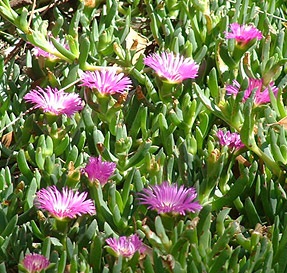
IP329 Karkalla ( Carpobrotus rossii )
An attractive succulent herb growing on cliffs and sand dunes in Australia in the states of Victoria and Tasmania, with triangular, blue-green leaves and showy hot pink to purple flowers, white toward the base, followed by red, fleshy, globe-shaped fruits.
The leaves and the fruits used to be eaten by the Aborigines. Carpobrotus rossii tolerates coastal and saline conditions and strong winds and will resist moderate freezes. Ideal for warm-temperate climates, in USDA Zones 9 and 10, it makes a superb and robust ground cover even on sand and rocks.
D9904 Pencil Tree ( Euphorbia tirucalli )
Pencil tree makes a great houseplant and is easy to grow. It is a tropical plant for zones 10 or higher outside, but readily grows inside with bright light and requires almost no care.
Use pencil tree as a patio plant in a container. In tropical and subtropical climates, pencil tree is used as a specimen or background plant, and in mixed hedges. Pencil tree is highly salt tolerant and is often grown in gardens near the beach.
Pencil tree grows with single or multiple trunks which support a tangle of light green, pencil thick, succulent branches with little sign of a leaf.
In warm, tropical regions, Pencil tree can reach a height of 20-30 feet with a 6-10 feet spread. The main trunk and branches are woody and brownish, but the younger branches are
green and cylindrical, looking like so many pencils. The leaves are tiny and are shed early.
What is usually called the flower is really a group of petal-like bracts (modified leaves). The true flowers, which are centered within the bracts, are inconspicuous.
All parts of Euphorbia tirucalli ooze a milky sap when damaged or cut. Contact with this sap may cause dermatitis in some people, and in the eyes the sap can cause temporary blindness which may last for several days.
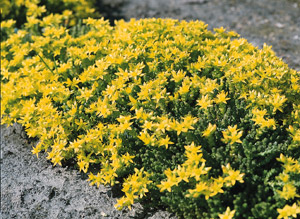
IP252 Stonecrop ( Sedum acre )
An excellent performing ground cover commonly known as Stonecrop. These ground cover plants form a brilliant, intense golden yellow carpet that will rapidly spread and fill in, giving you ground cover over a large area in a very short time.
It is so well-known and used that it has many common names: Goldmoss Stonecrop, Goldmoss Sedum, or Golden Carpet Stonecrop. It is a perennial plant native to Europe but also naturalized in North America.
Grows well in poor soils, sand, rock gardens, and rich dirt, in a variety of light conditions, but prefers mostly sunny conditions. It is such a versatile plant. Sedum Acre Stonecrop is well-suited for use in hanging baskets and container gardens as a trailing accent, as borders and edging in the flower garden, or as a general ground cover plant.
A perennial for zones 4-8.
Sedum seeds can be sown indoors or directly outdoors. Indoor sowing can be done 6-8 weeks before last frost date. Use small pots or flats and sterile starter mix.
Pre-moisten the starter mix and sow 5-7 Stonecrop seeds per container. The seeds are exceptionally small, so only press the ground cover seed into the moistened soil, and do not cover the seed. Keep the seeds moist but not saturated until they germinate.
For outdoor sowing, wait until garden soil temperatures are 70°F. Select a site with well-draining soil. If necessary amend soil with organic matter. Loosen the top 1-2 inches of soil, remove any weeds, and gently broadcast the seeds over the soil.
Lightly press the seeds into the soil, and keep the seed continuously moist until germination. Normal germination time is 14-28 days. As a rule of thumb, 500 sedum seeds will cover a 10 square foot area as a ground cover.
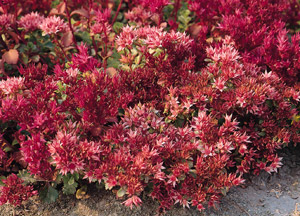
SF245 Stonecrop Dragon’s Blood ( Sedum spurium )
Dragon’s Blood Sedum is an easy-to-grow herbaceous perennial ground cover which can be grown in a container or used in mass plantings. Sedum ground cover plants are exceptionally tolerant of heat and drought and also tolerate to cold and humidity.
Dragon’s Blood Sedum is a fast growing ground cover with brilliant red flowers in late summer. It is a succulent with needle-like leaves that turn an orange-red color in fall. Dragon’s Blood ground cover creates a dense mat 3 – 5 inches tall that spreads quickly.
Dragon’s Blood will tolerate poor, dry soil. Low growing Sedum is used for containers, borders, edging and as a dense spreading ground cover plant. A perennial, these plants are great in rock gardens as they will grow in shallow, poor soil and perform well.
Dragon’s Blood seeds can be sown indoors or directly outdoors ( but you will get best results by starting indoors and transplanting outside ). Indoor sowing can be done 6 – 8 weeks before last frost date. Use small pots or flats and sterile starter mix. Pre-moisten the starter mix and sow 5 – 7 Sedum ground cover seeds per container. The Sedum seeds are exceptionally small, so only press the seed into the moistened soil, and do not cover the seed. Keep the seeds moist but not saturated until they germinate. For outdoor sowing, wait until garden soil temperatures are 70 degrees or higher. Select a site with well-draining soil. If necessary amend soil organic matter. Loosen the top 1 – 2 inches of soil, remove any weeds, and gently broadcast the Dragon’s Blood seeds over the soil. Lightly press the seeds into the soil, and keep the seed continuously moist until germination. Perennial growing 6″ tall, hardy for zones 3-9.
Source link

